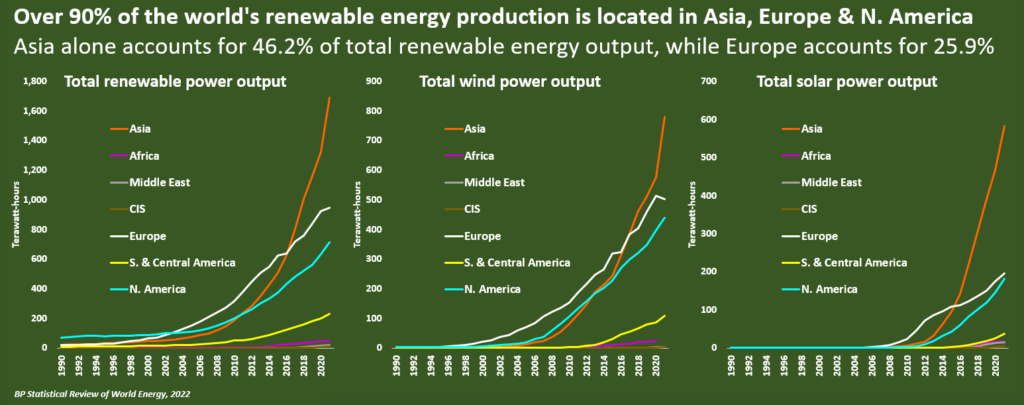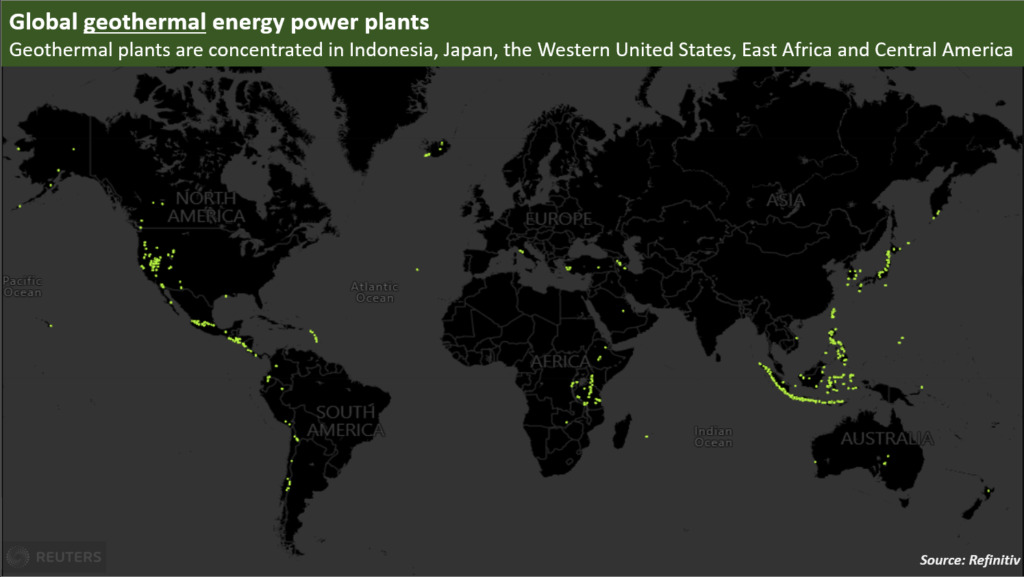Column: A global tour of key renewable energy hot – and cold – spots
The energy transition from fossil fuels to renewable power is a global undertaking, but Asia, Europe, and North America are the clear leaders in current capacity and future plans, and offer clues on the development pace and scale to expect elsewhere.
The below map made in Refinitiv Eikon shows the global sweep of power stations that generate electricity from renewable energy. Each dot represents an individual wind farm, solar plant, hydropower station, geothermal site or other facility that generates power from renewable sources.

The spread of facilities across most continents gives the impression that renewable energy supplies are well scattered throughout the world.
But in fact more than 90% of all renewable energy supply comes from Asia, Europe and North America, while the rest of the world accounts for less than 10%.

A map of global wind farms offers a more accurate representation of the breakdown in renewable installations.

Just over half of all renewable power comes from wind, and in this map, it’s clear that Asia – particularly China – boasts the highest concentration of wind projects, followed by Europe and North America.
China is also home to some of the world’s largest wind farms, including the Gansu Wind Farm Project which has a planned capacity of 20 gigawatts produced by over 7,000 turbines.
However, some of China’s windfarms are also among the most underutilized, with some not yet even connected to the grid so that the power they produce can be carried to consumption centers 1,000 miles (1,600 km) or more away.
China is upgrading its national grid to improve connectivity and reduce waste – a costly and lengthy undertaking that every major economy must also tackle to accommodate the intermittency of renewable power while ensuring stable energy supplies.
Other major wind installations include the 1.3 GW Hornsea 2 farm located offshore in the North Sea. The project, which has 165 turbines, became fully operational this year and together with sister installation Hornsea 1 can provide power to 2.5 million homes in Britain.
The Alta Wind Energy Center in California is the largest wind farm in the United States, the second-largest wind producer after China.
The global wind power map also shows where there’s an absence of wind projects, most obviously in Africa.
Africa is clearly a major potential market, but may need time and extensive funding to overcome the grid stability and connectivity hurdles seen elsewhere before the region embraces wind power more aggressively.
Rise and shine
Africa is also thin on solar farms, especially compared to world leader Asia, but is seeing rapid capacity expansions in Algeria, Egypt, South Africa and Nigeria that should help the continent catch up with other regions.
The top overall solar producer is China, but the largest single farm is the Bhadla Solar Park in Rajasthan, India, which spans an area of 5,700 hectares (14,100 acres) and has a 2.2 GW capacity.
Parts of the United States and southern Europe are also rapidly expanding solar installations, though cloudy northern Europe will struggle to match the efficiency potential seen elsewhere and likely opt for more wind power instead.
Hydro havens
Norway, Indonesia, Canada, Brazil and China are among the top producers of hydroelectric power, thanks to deft use of fjords, waterfalls, rivers and tidal flows in those regions.
China’s Three Gorges Dam is the world’s largest hydroelectric project, followed by Brazil’s Itaipu Dam on the border with Paraguay.
Hydro projects can be hard to get off the ground due to their expense, years-long construction times and considerable impact on their local environment.
Even so, development is underway in Pakistan, Nigeria and Ethiopia on projects that are expected to be online before the end of the decade.
Biomass and geothermal
Biomass energy is produced from once-living organisms such as wood, plants and pulp. It can emit large amounts of carbon dioxide and result in deforestation, so often meets fervent opposition in debates over whether it can be classified as renewable.
Many facilities, however, run on municipal waste, and so do help reduce the build up of refuse even as their emissions track record remains sketchy.
India, Brazil, Southeast Asia, China and Japan all have extensive biomass power sectors, though the Drax plant near York, England, is reportedly the world’s largest.
When it comes to geothermal power, many people think of Iceland, but the United States, Indonesia, Philippines and Turkey are top in terms of installed capacity, according to ThinkGeoEnergy.

Fast-growing and power-hungry economies such as Indonesia and Philippines both plan to more than double the amount of electricity generated from geothermal power in the decades ahead, which should help both economies reduce coal use.
(By Gavin Maguire; Editing by Christian Schmollinger)
{{ commodity.name }}
{{ post.title }}
{{ post.date }}

Comments